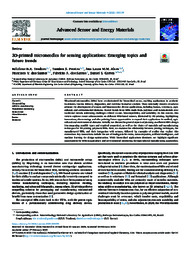Embrapa Instrumentação
3D-printed microneedles for sensing applications: Emerging topics and future trends.
Autoria: TEODORO, K. B. R.; PEREIRA, T. S.; ALVES, A. L. M. M.; SANTOS, F. V. dos; SANTOS, F. A. dos; CORREA, D. S.
Resumo: 3D-printed microneedles (MNs) have revolutionized the biomedical sector, enabling applications in aesthetic treatments, vaccine delivery, diagnostics, and real-time biomarker analysis. These minimally invasive structures advance the development of sensors and biosensors for diverse applications, including human, veterinary, agricultural, and environmental domains. Recent trends favor MNs made from polymers and nanomaterials over traditional metals, addressing challenges related to cost, biocompatibility, and scalability. In this context, this review explores recent advancements on different MNs-based sensors, fabricated by 3D printing, highlighting innovations, shortcomings and also pointing future opportunities to expand their applications in medical, agricultural and environmental domains. Initially, we discuss the general aspects of planning an efficient MN's design (encompassing possible types and required properties), as well as the choice of materials and manufacturing techniques for 3D printing polymeric MNs. Next, we examine the relationship between printing techniques, the manufactured MNs, and their integration with sensors, followed by examples of studies that explore this connection. Key innovations include the use of biodegradable resins, nanocomposites, artificial intelligence, and machine learning for design optimization. While biomedical applications dominate, we highlight significant opportunities for MNs in agriculture and environmental monitoring through tailored manufacturing approaches
Ano de publicação: 2025
Tipo de publicação: Artigo de periódico
Unidade: Embrapa Instrumentação
Palavras-chave: 3D-assembling, Additive manufacturing, Microfabrication, Point-of-care, Transdermal monitoring
